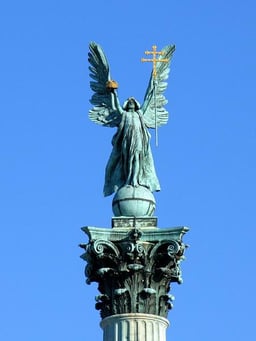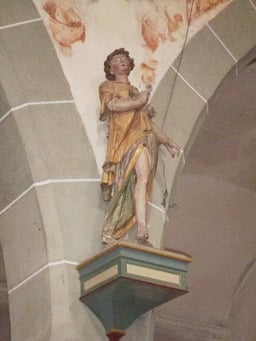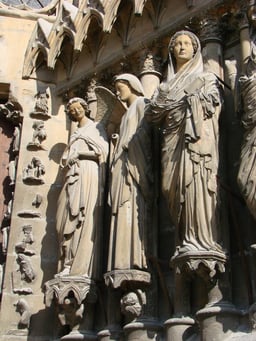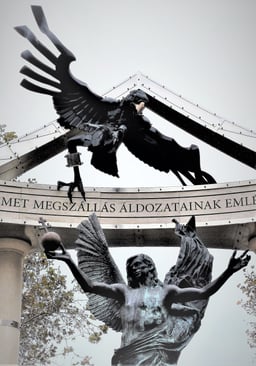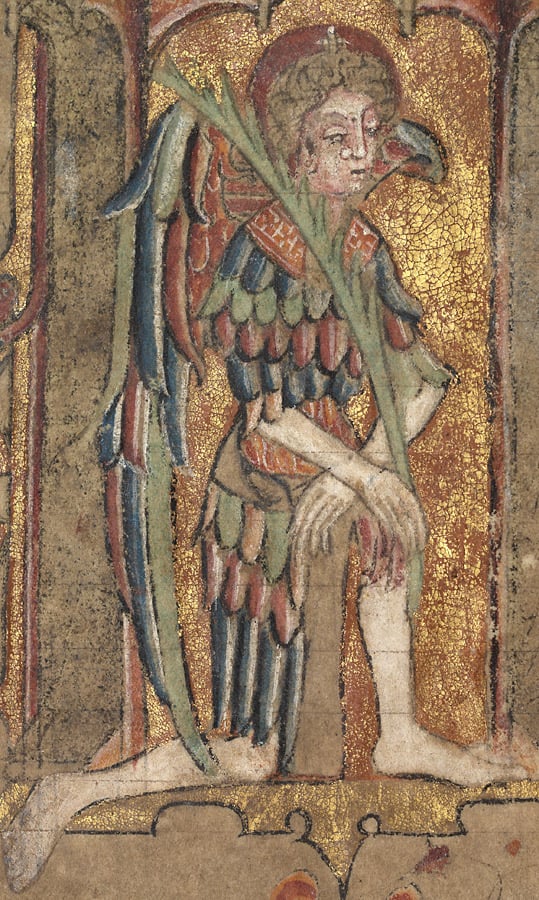Gabriel
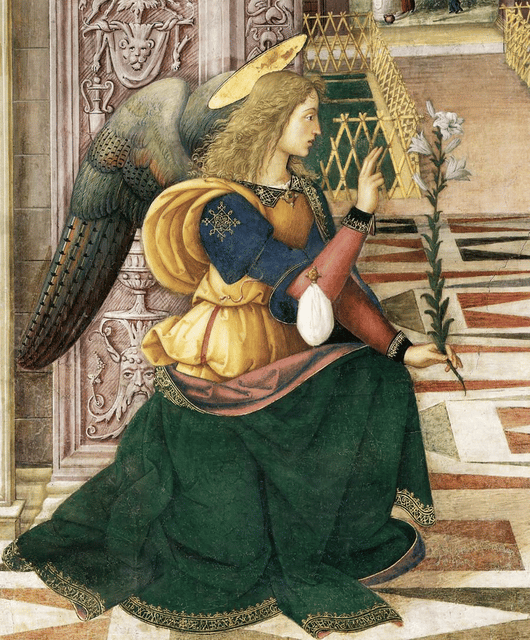
Gabriel

Gabriel | |
|---|---|
| Archangel, Angel of Revelation | |
| Venerated in | Judaism All Christian denominations which venerate saints Islam And Othersα |
| Canonized | Pre-Congregation |
| Feast |
|
| Attributes | Archangel;[1] Clothed in blue or white garments;[2] Carrying a lily,[2][3] a trumpet,[2] a shining lantern,[2] a branch from Paradise,[2] a scroll,[3] and a scepter.[3] |
| Patronage | Telecommunication Workers,[4][5] Radio Broadcasters,[5] Messengers,[5] Postal Workers,[5] Clerics,[5] Diplomats,[5] Stamp Collectors,[5] Portugal, Santander, Cebu, ambassadors |

Annunciation of Gabriel by Jan van Eyck, 1434.
Gabriel (/ˈɡeɪbriəl/; Hebrew: גַּבְרִיאֵל, lit. 'Gavri'el "God is my strength"', Ancient Greek: Γαβριήλ, lit. 'Gabriel', Coptic: Ⲅⲁⲃⲣⲓⲏⲗ, Aramaic: ܓܒܪܝܝܠ, Arabic: جبريل, Jibrīl or جبرائيل Jibrāʾīl), in the Abrahamic religions, is an archangel. He was first described in the Hebrew Bible and was subsequently adopted by other traditions.
In the Hebrew Bible, Gabriel appears to the prophet Daniel to explain his visions (Daniel 8:15–26, 9:21–27). The archangel appears in such other ancient Jewish writings as the Book of Enoch. Alongside archangel Michael, Gabriel is described as the guardian angel of Israel, defending this people against the angels of the other nations.[6]
The Gospel of Luke relates the stories of the Annunciation, in which the angel Gabriel appears to Zechariah and the Virgin Mary, foretelling the births of John the Baptist and Jesus, respectively (Luke 1:11–38). Many Christian traditions—including Anglicanism, Eastern Orthodoxy, and Roman Catholicism—revere Gabriel as a saint.[1][7]
The Latter Day Saints hold that the angel Gabriel is the same individual as the prophet Noah in his mortal ministry.[9][10]
Yazidis consider Gabriel one of the Seven Mysteries, the heptad to which God entrusted the world and sometimes identified with Melek Taus.[11]
Gabriel | |
|---|---|
| Archangel, Angel of Revelation | |
| Venerated in | Judaism All Christian denominations which venerate saints Islam And Othersα |
| Canonized | Pre-Congregation |
| Feast |
|
| Attributes | Archangel;[1] Clothed in blue or white garments;[2] Carrying a lily,[2][3] a trumpet,[2] a shining lantern,[2] a branch from Paradise,[2] a scroll,[3] and a scepter.[3] |
| Patronage | Telecommunication Workers,[4][5] Radio Broadcasters,[5] Messengers,[5] Postal Workers,[5] Clerics,[5] Diplomats,[5] Stamp Collectors,[5] Portugal, Santander, Cebu, ambassadors |
Judaism
Jewish rabbis interpreted the "man in linen" as Gabriel in the Book of Daniel and the Book of Ezekiel. In the Book of Daniel, Gabriel is responsible for interpreting Daniel's visions. Gabriel's main function in Daniel is that of revealer, a role he continues in later literature. In the Book of Ezekiel, Gabriel is understood to be the angel that was sent to destroy Jerusalem. According to the Jewish Encyclopedia, Gabriel takes the form of a man, and stands at the left hand of God.[12] Shimon ben Lakish (Syria Palaestina, 3rd century) concluded that the angelic names of Michael, Raphael, and Gabriel came out of the Babylonian exile (Gen. Rab. 48:9).[13] Alongside archangel Michael, Gabriel is described as the guardian angel of Israel, defending this people against the angels of the other nations.[6]
In Kabbalah, Gabriel is identified with the sephirah of Yesod. Gabriel also has a prominent role as one of God's archangels in the Kabbalah literature. There, Gabriel is portrayed as working in concert with Michael as part of God's court. Gabriel is not to be prayed to because only God can answer prayers and sends Gabriel as his agent.[12]
According to Jewish mythology, in the Garden of Eden there is a tree of life or the "tree of souls"[14] that blossoms and produces new souls, which fall into the Guf, the Treasury of Souls. Gabriel reaches into the treasury and takes out the first soul that comes into his hand. Then Lailah, the Angel of Conception, watches over the embryo until it is born.[15]
Intertestamental literature
The intertestamental period (roughly 200 BC – 50 AD) produced a wealth of literature, much of it having an apocalyptic orientation. The names and ranks of angels and devils were greatly expanded, and each had particular duties and status before God.
In 1 Enoch 9:1–3, Gabriel, along with Michael, Uriel and Suriel, "saw much blood being shed upon the earth" (9:1) and heard the souls of men cry, "Bring our cause before the Most High." (9:3) In 1 Enoch 10:1, the reply came from "the Most High, the Holy and Great One" who sent forth agents, including Gabriel—
And the Lord said to Gabriel: "'Proceed against the bastards and the reprobates, and against the children of fornication: and destroy [the children of fornication and] the children of the Watchers from amongst men [and cause them to go forth]: send them one against the other that they may destroy each other in battle: for length of days shall they not have." —1 Enoch 10:9
Gabriel is the fifth of the five angels who keep watch: "Gabriel, one of the holy angels, who is over Paradise and the serpents and the Cherubim." (1 Enoch 20:7)
When Enoch asked who the four figures were that he had seen: "And he said to me: 'This first is Michael, the merciful and long-suffering: and the second, who is set over all the diseases and all the wounds of the children of men, is Raphael: and the third, who is set over all the powers, is Gabriel: and the fourth, who is set over the repentance unto hope of those who inherit eternal life, is named Phanuel.' And these are the four angels of the Lord of Spirits and the four voices I heard in those days." (Enoch 40:9)
Christianity
New Testament

Archangel Gabriel. A fresco from the Tsalenjikha Cathedral by Cyrus Emanuel Eugenicus. 14th century
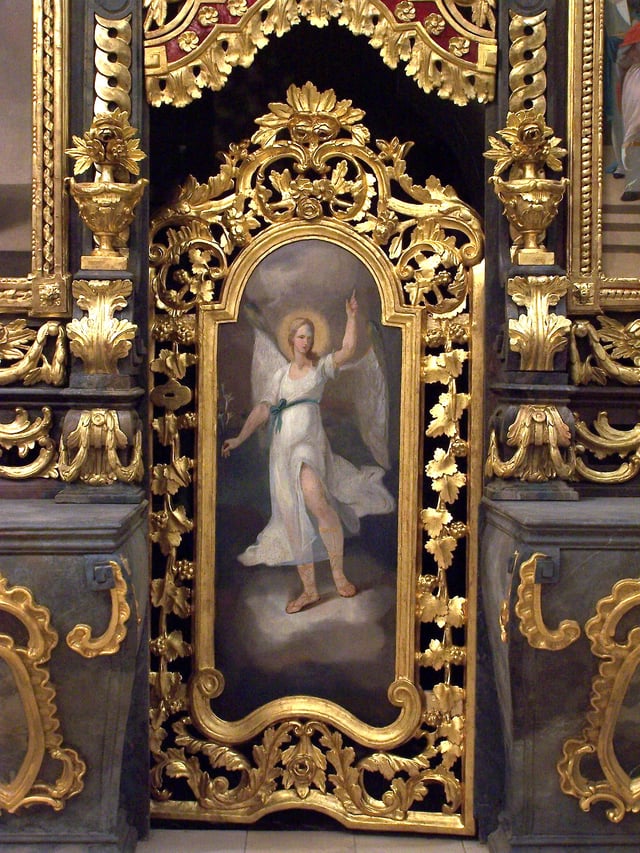
Gabriel on the southern deacons' door of the iconostasis in the Cathedral of Hajdúdorog, Hungary.
First, concerning John the Baptist, an angel appeared to his father Zacharias, a priest of the course of Abia, (Luke 1:5-7) whose barren wife Elisabeth was of the daughters of Aaron, while he ministered in the temple:
Luke 1:10 And the whole multitude of the people were praying without at the time of incense. 11 And there appeared unto him an angel of the Lord standing on the right side of the altar of incense. 12 And when Zacharias saw him, he was troubled, and fear fell upon him. 13 But the angel said unto him, Fear not, Zacharias: for thy prayer is heard; and thy wife Elisabeth shall bear thee a son, and thou shalt call his name John. 14 And thou shalt have joy and gladness; and many shall rejoice at his birth. 15 For he shall be great in the sight of the Lord, and shall drink neither wine nor strong drink; and he shall be filled with the Holy Ghost, even from his mother's womb. 16 And many of the children of Israel shall he turn to the Lord their God. 17 And he shall go before him in the spirit and power of Elias, to turn the hearts of the fathers to the children, and the disobedient to the wisdom of the just; to make ready a people prepared for the Lord. 18 And Zacharias said unto the angel, Whereby shall I know this? for I am an old man, and my wife well stricken in years. 19 And the angel answering said unto him, I am Gabriel, that stand in the presence of God; and am sent to speak unto thee, and to shew thee these glad tidings. 20 And, behold, thou shalt be dumb [deaf], and not able to speak, until the day that these things shall be performed, because thou believest not my words, which shall be fulfilled in their season. (Luke 1:10-20 KJV) (other versions: Luke 1:1-25 [84] )
Luke 1:26 ¶ And in the sixth month the angel Gabriel was sent from God unto a city of Galilee, named Nazareth, 27 To a virgin espoused to a man whose name was Joseph, of the house of David; and the virgin's name was Mary. 28 And the angel came in unto her, and said, Hail, thou that art highly favoured, the Lord is with thee: blessed art thou among women. 29 And when she saw him, she was troubled at his saying, and cast in her mind what manner of salutation this should be. 30 And the angel said unto her, Fear not, Mary: for thou hast found favour with God. 31 And, behold, thou shalt conceive in thy womb, and bring forth a son, and shalt call his name JESUS. 32 He shall be great, and shall be called the Son of the Highest: and the Lord God shall give unto him the throne of his father David: 33 And he shall reign over the house of Jacob for ever; and of his kingdom there shall be no end. 34 Then said Mary unto the angel, How shall this be, seeing I know not a man? 35 And the angel answered and said unto her, The Holy Ghost shall come upon thee, and the power of the Highest shall overshadow thee: therefore also that holy thing which shall be born of thee shall be called the Son of God. 36 And, behold, thy cousin Elisabeth, she hath also conceived a son in her old age: and this is the sixth month with her, who was called barren. 37 For with God nothing shall be impossible. 38 And Mary said, Behold the handmaid of the Lord; be it unto me according to thy word. And the angel departed from her. (Luke 1:26-38 KJV) (other versions: Luke 1:26-38 [85] )
Gabriel only appears by name in those two passages in Luke. In the first passage the angel identified himself as Gabriel, but in the second it is Luke who identified him as Gabriel. The only other named angels in the New Testament are Michael the Archangel (in Jude 1:9) and Abaddon (in Revelation 9:11). Gabriel is not called an archangel in the Bible. Believers are expressly warned not to worship angels (in Colossians 2:18-19 and Revelation 19:10).[18]
Gabriel's horn
The trope of Gabriel blowing a trumpet blast to indicate the Lord's return to Earth is especially familiar in Spirituals. However, though the Bible mentions a trumpet blast preceding the resurrection of the dead, it never specifies Gabriel as the trumpeter. Different passages state different things: the angels of the Son of Man (Matthew 24:31); the voice of the Son of God (John 5:25-29); God's trumpet (I Thessalonians 4:16); seven angels sounding a series of blasts (Revelation 8-11); or simply "a trumpet will sound" (I Corinthians 15:52).[19]
In related traditions, Gabriel is again not identified as the trumpeter. In Judaism, trumpets are prominent, and they seem to be blown by God himself, or sometimes Michael. In Zoroastrianism, there is no trumpeter at the last judgement. In Islamic tradition, it is Israfil who blows the trumpet, though he is not named in the Qur'an. The Christian Church Fathers do not mention Gabriel as the trumpeter; early English literature similarly does not.[19]
The earliest known identification of Gabriel as the trumpeter comes in John Wycliffe's 1382 tract, De Ecclesiæ Dominio.[20] In the year 1455, in Armenian art, there is an illustration in an Armenian manuscript showing Gabriel sounding his trumpet as the dead climb out of their graves.[21] Two centuries later, Gabriel is identified as the trumpeter, in John Milton's Paradise Lost (1667):[19][22]
Betwixt these rockie pillars Gabriel sat Chief of the Angelic guards (IV.545f)... He ended, and the Son gave signal high To the bright minister that watch'd, he blew His trumpet, heard in Oreb since perhaps When God descended, and perhaps once more To sound at general doom. (XI.72ff).
Later, Gabriel's horn is omnipresent in Negro spirituals, but it is unclear how the Byzantine conception inspired Milton and the spirituals, though they presumably have a common source.[19]
Gabriel's horn also makes an appearance in The Eyes of Texas (1903) where it signifies the rapture.[23]
In Marc Connelly's play based on spirituals, The Green Pastures (1930), Gabriel has his beloved trumpet constantly with him, and the Lord has to warn him not to blow it too soon.[19] Four years later "Blow, Gabriel, Blow" was introduced by Ethel Merman in Cole Porter's Anything Goes (1934).
Feast days

Icon of Gabriel, Byzantine, ca. 1387–1395 (Tretyakov Gallery)
Saint Gabriel Archangel's festivity day was exclusively celebrated the 18th of March as of many sources dating between the years 1588 and 1921, except for a source published in 1856,[24] where the feast was celebrated on April 7 for unknown reasons (a parentheses notes that the day is normally celebrated on 18 March). Writer Elizabeth Drayson mentions the feast being celebrated in March 18 the year of 1588 in her 2013 book: "The Lead Books of Granada". Drayson, Elizabeth (January 13, 2016). The Lead Books of Granada [86] . Palgrave Macmillan - 2013 edition. p. 3. ISBN 113735884X.
One of the oldest out of print sources pronouncing the feast for 18 March, was first published in 1608 and has the name "Flos sanctorum: historia general de la vida y hechos de Jesu-Christo ... y de los santos de que reza y haze fiesta la Iglesia Catholica ..." by the Spanish writer Alonso de Villegas, a newer edition of this book was published in the year 1794.[25] Another source published in Ireland in 1886 «The Irish Ecclesiastical Record» also mentions March 18.[26] There is a painting from 1886 by the Italian artist Diodore Rahoult, the 18th of March appears on the painting as well.[27]
The feast of Saint Gabriel was included by Pope Benedict XV in the General Roman Calendar in 1921, for celebration on 24 March.[28] It is unknown whether this was a temporary change, however there is no recent mention of the feast commemoration between the years 1921 and 1969. In 1969 the day was officially transferred to 29 September for celebration in conjunction with the feast of St. Michael and St. Raphael.[29] The Church of England has also adopted the 29 September date, known as Michaelmas.
The Eastern Orthodox Church and those Eastern Catholic Churches which follow the Byzantine Rite celebrate his feast day on 8 November (for those churches that follow the traditional Julian Calendar, 8 November currently falls on 21 November of the modern Gregorian Calendar, a difference of 13 days). Eastern Orthodox commemorate him, not only on his November feast, but also on two other days: 26 March is the "Synaxis of the Archangel Gabriel" and celebrates his role in the Annunciation.
13 July is also known as the "Synaxis of the Archangel Gabriel", and celebrates all the appearances and miracles attributed to Gabriel throughout history. The feast was first established on Mount Athos when, in the 9th century, during the reign of Emperor Basil II and the Empress Constantina Porphyrogenitus and while Nicholas Chrysoverges was Patriarch of Constantinople, the Archangel appeared in a cell[30] near Karyes, where he wrote with his finger on a stone tablet the hymn to the Theotokos, "It is truly meet...".[31]
The Ethiopian Church celebrates his feast on 28 December, with a sizeable number of its believers making a pilgrimage to a church dedicated to "Saint Gabriel" in Kulubi on that day.[34]
Additionally, Gabriel is the patron saint of messengers, those who work for broadcasting and telecommunications such as radio and television, postal workers, clerics, diplomats, and stamp collectors.[5]
Latter-day Saint teachings
Islam
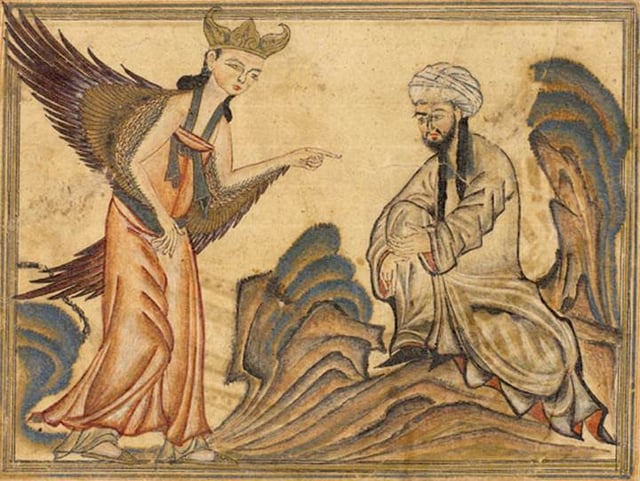
Gabriel (Arabic: جبرائيل Jibrāʾīl[35] or جبريل, Jibrīl in Modern Cairo Edition[36]) is venerated as one of the primary archangels and as the Angel of Revelation in Islam. Exegesis narrates that Muhammad saw Gabriel in his full angelic splendor only twice, the first time being when he received his first revelation.[37] As the Bible portrays Gabriel as a celestial messenger sent to Daniel,[38] Mary,[39] and Zechariah,[40] so too Islamic tradition holds that Gabriel was sent to numerous pre-Islamic prophets with revelation and divine injunctions, including Adam, whom Muslims believe was consoled by Gabriel some time after the Fall.[41] He is known by many names in Islam, such as "keeper of holiness", "peacock of paradise".[42]
Gabriel is commonly identified as the Holy Spirit. Though alternate theories exist, thus whether the occurrence of the Holy spirit in the Quran refers to Gabriel or not, remains an issue of scholarly debate. In the Quran, Gabriel appears named in 2:92-96 [87] , 2:97 [88] and 66:4 [89] . In 2:92-96 [90] , the Quran mentions Gabriel along with Michael.
Muslims also revere Gabriel for a number of historical events predating the first revelation. Muslims believe that Gabriel was the angel who informed Zachariah of John's birth as well as Mary of the future nativity of Jesus,[43] and that Gabriel was one of three angels who had earlier informed Abraham of the birth of Isaac.[44] All of these events can be found also in the Quran. Gabriel also makes a famous appearance in the Hadith of Gabriel, where he questions Muhammad on the core tenets of Islam.
Contrary to Christian tradition, Islamic traditions depict Gabriel as the warring angel, instead of Michael. Accordingly, he aided Muhammed to overcome his adversaries, significantly during the Battle of Badr and against a demon during the Mi'raj.[45][46] Further, similar to Gabriel in Judaism, Gabriel is also an angel responsible for the acts of destruction of people God wants to be annihilated.[47]
Art, entertainment, and media

The Annunciation, Henry Ossawa Tanner (1898)
Angels are described as pure spirits.[48][49] The lack of a defined form allows artists wide latitude in depicting them.[50] Amelia R. Brown draws comparisons in Byzantine iconography between portrayals of angels and the conventions used to depict court eunuchs. Mainly from the Caucasus, they tended to have light eyes, hair, and skin; and those "castrated in childhood developed a distinctive skeletal structure, lacked full masculine musculature, body hair and beards...." As officials, they would wear a white tunic decorated with gold. Brown suggests that "Byzantine artists drew, consciously or not, on this iconography of the court eunuch".[51] Some recent popular works on angels consider Gabriel to be female or androgynous.[52][53]
Gabriel sculptures
Festivals
Film
In the 1930 film, Liliom, Gabriel was portrayed by Harvey Clark.
In the 1936 film, The Green Pastures, Gabriel was portrayed by Oscar Polk.
In the 1947 film, Heaven Only Knows, Gabriel was portrayed by William Farnum.
In the 1995 horror film The Prophecy – Gabriel, portrayed by Christopher Walken, searches for an evil soul on Earth during an end-of-days angelic civil war. Gabriel is also a character in The Prophecy II (1998) and The Prophecy 3: The Ascent (2000).
In the 2004 action / horror film Van Helsing – Hugh Jackman plays Gabriel Van Helsing, called Abraham Van Helsing in Bram Stoker's Dracula. It has been suggested that he is the archangel in human form.[56]
In the 2005 fantasy/horror film Constantine – Tilda Swinton portrays an androgynous archangel Gabriel, the film's main antagonist on the brink of the Apocalypse.
In the 2007: action / horror film Gabriel – Gabriel (portrayed by Andy Whitfield) fights to save the souls in purgatory by defeating the evil fallen angels.
In the 2010: apocalyptic supernatural action film Legion – Kevin Durand plays the role of Archangel Gabriel, the leader of the angel army, and the main antagonist. The story was continued in the TV series Dominion.
Games
2005: Spanish role-playing game Anima: Beyond Fantasy - Gabriel is as the humans know one of the seven "Beryls" (godlike beings of light) and is identified with the archangel of the same name. She has associated love, friendship, arts, and peace.
In the Japanese role-playing game Shin Megami Tensei - Gabriel is one of the Demons the player can summon to assist in battle.
In the video game El Shaddai: Ascension of the Metatron, based on the Book of Enoch, Gabriel is featured alongside Michael, Raphael and Uriel as a guide for Enoch on his quest. All four archangels take the form of swans while on Earth. Gabriel is depicted as female in this interpretation, and implied to be an angel of wisdom. She is associated with the Veil weapon Enoch uses.
Literature
In his epic poem Paradise Lost, John Milton made Gabriel chief of the angelic guards placed over Paradise
The Hebrew poem "Elifelet" (אליפלט) by Nathan Alterman, put to music and often heard on the Israeli Radio, tells of a heroic, self-sacrificing Israeli soldier being killed in battle. Upon the protagonist's death, the angel Gabriel descends to Earth, in order to comfort the spirit of the fallen hero and take him up to Heaven[57][58]
The main character of Salman Rushdie's The Satanic Verses (1988) believes that he is the modern incarnation of Gabriel
2012: Japanese light novel series No Game No Life, Jibril is a member of the Flügel race and was a member of the Council of 18 Wings, a prominent section in the government. She is depicted as loving knowledge and books.
In the volume 3 of the Japanese light novel series The Devil Is a Part-Timer!, an archangel named Gabriel appeared and is the guardian of the Sephirah Yesod.
In the Japanese light novel High School DxD features Gabriel, alongside the rest of the Seraph. In High School DxD, Gabriel is depicted as a female and is given the titles of "The Strongest Woman in Heaven" and "The Most Beautiful Woman in Heaven".
In August Wilson's Fences (1986), the mentally handicapped character Gabriel believes with every fibre of his soul that he is the Archangel Gabriel. He carries around a trumpet on him always, and strives to chase away the "hellhounds". In the last scene of the play, he calls for Saint Peter to open up the gates.
Music
The eccentric English hagiographer and antiquarian, Sabine Baring-Gould (1834–1924), wrote the English lyrics to Gabriel's Message, which he translated from the Basque Christmas carol Birjina gaztetto bat zegoen, which was probably related to the 13th or 14th-century Latin chant Angelus Ad Virginem, which itself is based on the biblical account of the Annunciation in the Gospel of Luke. In Creed's song, "My Own Prison", Gabriel is mentioned deciphering the visions to the main character in the song. "Sugar Baby", the last track on Bob Dylan's Love and Theft album, contains this reference: "Just as sure as we're living, just as sure as we're born/ Look up, look up - seek your Maker - 'fore Gabriel blows his horn."
Visual art

Detail of Gabriel from Leonardo da Vinci's Annunciation (c. 1472-1475)

Angel of the Annunciation by Titian (1520-1522)
- *See alsoGabriel gallery in Commons*.
Daniel 8:15 describes Gabriel as appearing in the "likeness of man" and in Daniel 9:21 he is referred to as "the man Gabriel." David Everson observes that "such anthropomorphic descriptions of an angel are consistent with previous ... descriptions of angels," as in Genesis 19:5.[13]
Gabriel is most often portrayed in the context of scenes of the Annunciation. In 2008 a 16th-century drawing by Lucas van Leyden of the Netherlands was discovered. George R. Goldner, chairman of the department of prints and drawings at New York's Metropolitan Museum of Art, suggests that the sketch was for a stained glass window. "The fact that the archangel is an ordinary-looking person and not an idealized boy is typical of the artist", said Goldner.[59]
In chronological order (to see each item, follow the link in the footnote):[60]
Archangel Gabriel (Triptych), early 10th century, Benaki Museum
The Archangel Gabriel, Pisan, c. 1325/50, National Gallery of Art
The Archangel Gabriel, Masolino da Panicale, c. 1420/30, National Gallery of Art
Justice between the Archangels Michael and Gabriel, Jacobello del Fiore, 1421
Merode Altarpiece (Triptych), Robert Campin, c. 1425, Metropolitan Museum of Art
The Angel Gabriel, Agostino di Duccio, c. 1450
Annunciation, Leonardo da Vinci, c. 1475
The Angel Gabriel, Neroccio d'Landi, c. 1490
The Angel Gabriel, late 15th or early 16th century, Flemish, National Gallery of Art
The Angel Gabriel, Ferrari Gaudenzio, 1511, National Gallery, London
Gabriel delivering the Annunciation El Greco, 1575 (pictured above)
Go Down Death, Aaron Douglas, 1934
The Military Order of Saint Gabriel was established to recognize "individuals who have made significant contributions to the U.S. Army Public Affairs community and practice." The medallion depicts St. Gabriel sounding a trumpet, while the obverse displays the Army Public Affairs emblem.[61]
Television
1960: The Twilight Zone episode, "A Passage for Trumpet" – The down-and-out musician Joey Crown (Jack Klugman) meets an enigmatic trumpet player named "Gabe" (played by John Anderson), in what has been described as Rod Serling's version of It's a Wonderful Life.[62]
1969: television film The Littlest Angel, Gabriel was portrayed by Cab Calloway.
1999: television film Jesus, Gabriel was portrayed by John Light.
2005: TV series Supernatural – Gabriel (Richard Speight Jr.) is a runaway archangel posing as the demigod Loki who kills people he deems evil with a sense of humor, but series protagonists Sam and Dean Winchester eventually discover his true nature. He is also known as "the Trickster".
2014: Syfy Channel original series Dominion – Gabriel (portrayed by Carl Beukes) is the series antagonist, who plans to kill the Archangel Michael and annihilate humanity.
2019: STARZ TV series Now Apocalypse - Gabriel (portrayed by Tyler Posey) is an enigmatic trumpet player who has a passionate tryst with series protagonist Ulysses Zane before warning him about an impending apocalypse.
2019: Amazon Prime miniseries Good Omens (based on the novel by Terry Pratchett and Neil Gaiman) - Gabriel was portrayed by Jon Hamm.
See also
Angel of the Lord
Angelus
Annunciation
Christian angelic hierarchy
Fleur de lys
Gabriel's Horn, a mathematical figure
Hermes
List of angels in theology
List of names referring to El
Saint Gabriel, patron saint archive
Seraph
